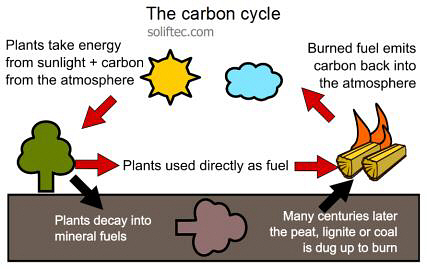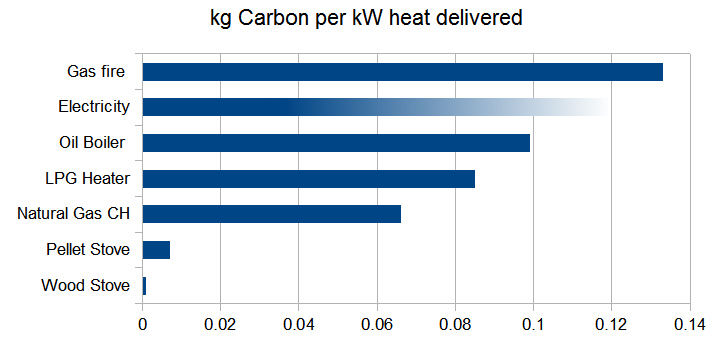

|
|
|
|
THE CARBON CYCLE See also: Fuel Costs and carbon emissions online calculator and Wood Fuel. Carbon is the fourth most abundant element in the universe, and it is the basis of all organic matter. Plants, such as trees, are made from air and water - they use the sun's energy to take in carbon from the air and create growth. When the plant dies and rots, or we burn it, the carbon in it combines with oxygen in the air to make the invisible gas Carbon Dioxide (CO2), which goes back into the air to be taken back up by new plant growth. As long as the fuel is renewed this simple cycle is in balance, all is well. But we humans have been burning huge amounts of the coal, oil and gas which are the fossil of organic material which died millions of years ago and so are releasing vast quantities of stored-up carbon into the atmosphere very quickly. It appears to be the case that this carbon build-up is increasing the 'greenhouse effect' and making the earth get warmer. The temperature rise has only been a degree or so over the last 100 years, but, unless something is done to reduce carbon emissions there is a fear that this warming may become very dangerous indeed.  Heating accounts for nearly half of Europe's carbon emissions. Coal, oil and gas are all major emitters of carbon, and therefore need to be used with great care. But burning Wood Fuel, and other recently-harvested biofuels, can never emit more carbon than the plant took in when it was alive. As long as new growth is planted as the old growth is burned - and that is what happens throughout Europe - then biofuels are considered to be "carbon neutral", apart from a small carbon 'overhead' from the fossil fuels like oil used to process and transport them. (Electricity, even though it produces no emissions at the point of use, it is still substantially made using fossil fuels and at relatively poor efficiency.)  The chart above is an approximation for heat delivered allowing for efficiency losses, the 'raw' figures are...
Carbon intensity of Electricity depends on the fuel used to make it, in the UK see https://carbonintensity.org.uk THIS IS BASED ON: Emission Factors for Greenhouse Gas Inventories (UK 2021) www.gov.uk/government European Environment Agency: www.eea.europa.eu MORE: Wikipedia: The Carbon Cycle  https://en.wikipedia.org/wiki/Carbon_cycle https://en.wikipedia.org/wiki/Carbon_cycleThe United Nations: Climate Change Centre  https://unfccc.int https://unfccc.int |
|
MORE FROM Soliftec... Home ● Fuel Costs ● Installation ● Library ● About ● Air Supply ● Blogspot ● Building Rules ● Carbon Monoxide ● CE Marking ● Dictionary ● Efficiency ● Electricity - CHP ● Embodied Energy ● Fascinating Facts ● Fireplace Doctor ● Fuel Properties ● Heat Need ● Heroes ● Legislation ● Manufacturers ● Open Fires ● Ringelmann Scale ● Smog and Smoke Control ● Smoke ● Solid Fuels ● Standards ● Statistics ● Stove History ● Tables, Data and Formulas ● Test Laboratories ● Thatched Roofs ● The Carbon Cycle ● The Chimney Effect ● Wood Fuel ● Email: info@soliftec.com COPYRIGHT and ALL RIGHTS RESERVED: © Soliftec Ltd, Thursday 06 January 2022 BUILT WITH WHIMBERRY matrixstats |